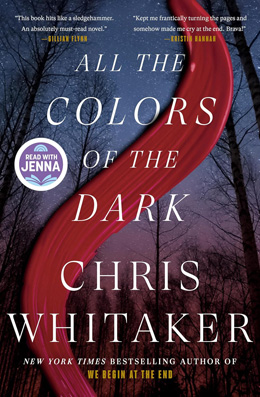The epic scope of a tale like Homer’s The Odyssey resonates universally because at its core it is simply the story of man on a journey home—albeit a circuitous route fraught with peril and temptation at every unplanned turn. While it is a completely different type of story, Chris Whitaker’s All the Colors of the Dark very much echoes this “intimate epic” aesthetic. Despite being about citizens from small town America (Monta Clare, Missouri) during a specific period of time (1975-2001) faced with a unique dilemma (the rampage of a serial killer), All the Colors of the Dark strangely feels untethered by location, time, and/or circumstance.
Fans of William Kent Kruger and Stephen King will delight in Chris Whitaker’s examination of that inevitable period between adolescence and adulthood. All the Colors of the Dark clocks in at just under 600 pages and 261 chapters. While this sounds like an intimidating tome, the brevity of every chapter—there isn’t one that is longer than five pages—keeps the pages turning allowing the readers to fall under the spell of this complex narrative.
The two main characters of the story are Patch and Saint. Patch is a thirteen-year-old boy who was born with only one eye and rather than dwell in despair chooses to celebrate his destiny as a pirate (facilitated by the various, color-coordinated namesake patches that help to disguise his differentness). A direct peer, Saint is a girl whose fascination with beekeeping stems from being raised by her grandmother who teaches her about loyalty, love, and the bonds of community. Patch and Saint are inseparable, when a momentary action—saving the daughter of a rich businessman from possible abduction—spurs a decades-long journey that will alter the core of every citizen of Monta Clare.
Not much can be said about the plot of this finely wrought novel that continually defies the readers expectations by morphing from one thing to another. It’s a love story rooted in mystery with adventure and thrills coming from the most unlikely of directions. This is a prime example of a novel critics will struggle to explain and marketing departments will be challenged to sum up using trendy genre creations. It can be all the things—mystery, thriller, romance, bildungsroman—while simultaneously also being none of them as we currently know and expect them to be. At times grandiose and exhausting juxtaposed with moments of pure beauty and brilliance, whatever one calls it, it works.
Chris Whitaker peppers the storyline with cultural references that help the reader to relate to the action on the page. From movies to music, each allusion is carefully chosen for maximum impact and many of them become motifs that resonate across the scope of the novel. His gift for the written word also wrings every emotion out of his reader.
Any reader who experiences All the Colors of the Dark will never forget having done so. It’s the type of novel that becomes a cultural touchstone, used to illustrate a specific aesthetic for discussion, analysis, and comparison. Revisiting this novel at different stages in one’s life is also likely to result in different takeaways. With All the Colors of the Dark, Chris Whitaker has crafted a book that will mean different things to different people, even while it unites us under the same universal human condition.

BUY LINKS: All the Colors of the Dark by Chris Whitaker
